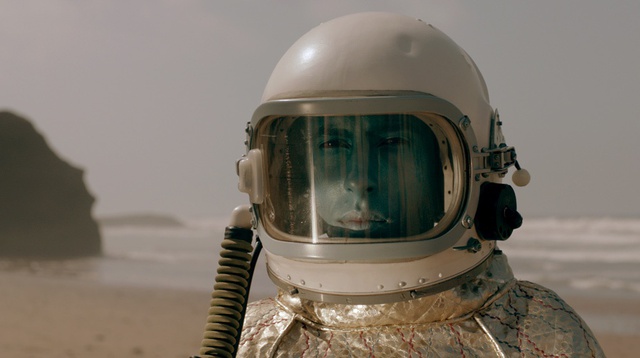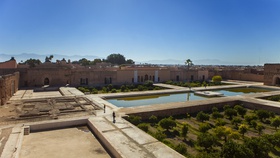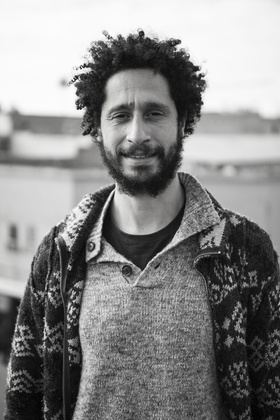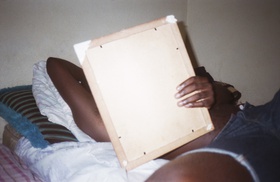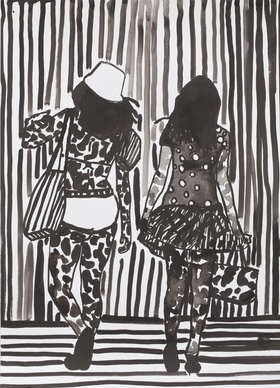Interviews
Where Are We Now?
Hicham Khalidi in conversation with Daniella Rose King
The fifth edition of the Marrakech Biennale, Where are we now?, opened on 26 February 2014 and continues until 31 March. The Biennale's Curator of the Visual and Sound Art Programme Hicham Khalidi, invited over 30 international artists and 11 Moroccan artists to consider the sites of their display, and the specificities of identity and location in the multilingual and geopolitically nuanced city of Marrakech. In this interview, Khalidi discusses his curatorial framework; the historic venues that house the programme; and his experience of working in the Maghreb. Framing the biennial and his selection of artists around ideas of 'free zones', diasporas and identities, Khalidi provides an insight into the specific challenges he encountered, as well as the unexpected conversations that arose between the works, their locations and the biennial's audiences.
Daniella Rose King: How and when did you become involved with the Marrakech Biennale?
Hicham Khalidi: I got involved with the biennial doing another show titled On Geometry and Speculation: A Parallel Between the Islamic Golden Age and Western Contemporary Art. This was as a parallel project, part of the fourth edition of the Marrakech Biennale. So when I pitched to become the next Biennale curator, I succeeded.
DRK: There was some international and national discontent at the last Marrakech Biennale, in that it only showed the work of two Moroccan artists. What did you think of this? And was this something that was present in your mind while you were curating this years' iteration?
HK: Yes, but I did not want to follow this critique in my own thinking in terms of how to devise the selection for this edition. I was interested in the diaspora and the movement of artists globally, as well as art practice of Moroccans living and working in Morocco. The selection made was an accumulation of that.
DRK: Could you explain the curatorial framework/rationale for the visual arts and sound programme? Could you talk a little about specific art works in relation to your curatorial perspective here? Is there something that ties the works together?
HK: My curatorial framework deals on the one hand with the geopolitical shift of the 'West', 'South', and 'East' from a migrant's point of view. Meaning, how North African migrants changed their perspectives from the 'West' to the countries of their origins, and how Morocco as a country is affiliated with the 'West' but works with the 'East' and Middle East. I find this reflected in the selection of artists. On the other hand, I was interested in national identity and how artists' strategies could function as a model for a new plural identity. I feel a lot of artists seek a sort of a transnational transit zone to live and work in, and that art works function as these fictional 'free zones' wherein artists can experiment with ideas such as plural identities, cultural ambiguity, or miscommunication as a model to understand what a country is and how it works. My question here was: is a plural national identity possible, one which is constructed from a non-hierarchical (with many centres) as opposed to a hierarchical point of view (from one centre)?
This was the starting point. Also, I did a lot of research in order to understand the position of Marrakech within the history of Morocco and the Maghreb. I made a reader for the artists as a basis to work with. The reader contained text and images of sites that were important for establishing Marrakech. Some of the artists chose to work within the context and some chose not to.
Another point of reference was the choice of different venues. I had chosen five distinct venues: Palais Badii, the former sixteenth century palace of Ahmed Al Mansur; Dar Si Said, the former house of General Si Said and which houses the Museum of Moroccan Art; Banque du Maghreb, the old central bank of Marrakech; Theatre Royale, the abandoned and uncompleted opera house in Gueliz; and L'Blassa, an Art Deco apartment building on the Rue de Liberte. Each venue has its specificities.
What was important for me was that the specificity of the venue called for a different approach. Palais Badii functions as a sculpture park, Dar Si Said as a site of artistic interventions, the Banque eventually became a selection of existing works with some new artist commissions that dealt with identity, tourism and migration. I chose a sound installation for the Theatre Royale (as its reference of a never-used opera house called for an intervention such as that). In Rue de Liberte I showed the work of Lebanese-Australian artist Khaled Sabsabi. The large 3D five-channel video work, 70,000 Veils (2014) explores the Prophet Mohammed's teaching that there are 70,000 veils of light and darkness separating the individual from the divine. The five screens are divided into a hundred screens with daily footage of the artist. The images move very slowly, and it is hard to discern one frame from the other, enhancing the immersive character of the piece.
It is important for me to see the venues as different exhibitions, which all relate to the theme as a whole. For instance, at Palais Badii, the work Towards the Possible Film (2014) of artist Shezad Dawood, shot on location at Sidi Ifni, a small village in the South Sea side of Morocco, shows the violent confrontation of a fictional tribe with aliens from the sea. The tribe speaks Berber and so refers to the original inhabitants of Morocco. The confrontation recalls a conflict of difference, misunderstanding and fear. Subsequently the film is subtitled in Arabic, French and English. Kader Attia's Political Anthropophagy (2014) presents found helmets used in the Rif War of the early 1920s, rearranged. The Rif is the Northern region of Morocco, and the helmets are reworked into Moroccan lutes, which puts an emphasis on war and music, deconstruction and construction. Attia refers to the helmet/musical instrument hybrids as a product of a process of repair and re-appropriation. Forming the background to these helmet instruments, Attia invoked the story of the Rif ruler Abdelkarim, who lost the first war for independence in Africa to the French due to a smart propaganda machine. The instruments are staged within a large cabinet, with newspapers and contemporaneous documents on the Rif war. Alongside the helmets, Attia presents remnants of war utilities that were rearranged by soldiers into decoration artefacts. Furthermore, in Indian artist Asim Waqif's The Pavilion of Debris (2014), the artist used found remains of the palace and reworked them into a large 20 metre by 8 metre-long musical instrument, emphasizing this process of repair and re-appropriation even more.
At Dar Si Said, there are works of a completely different character. Most of the works here play with the context of this former residence of General Si Said, which houses more than 5,000 artefacts collected in the period prior to and after 1920, the date that the French confiscated the residence and turned it into a museum. Dar Si Said is a place where artefacts that are displayed for the public have an in-between status of presence and non-presence. The objects have remained untouched in their cabinets for years. Neither the museum nor the Ministry of Culture, which owns the museum now (responsibilities have shifted to the Foundation of Museums), takes any effort to change the objects status by researching them and giving them historical references and relationships. The objects are there but at the same time remain absent.
This idea of presence and non-presence gave way to some of the works of Walid Raad at Dar Si Said. For instance, View from inner to outer compartment (2014) shows two facing vitrines of the museum made completely into compartments of mirrors. In the compartments two objects found in the museum collection were placed with the back of the objects facing the viewer. The front is facing the mirror but despite the ability of a mirror to reflect a non-visible side of an object, the viewer cannot see the objects completely, rendering the objects into present-absent objects. This is the poetical work of a great master! Another work that plays well with the context of the location is MurMurMur (2014) by Gabriel Lester. Here, the artist rebuilt a corridor with walls containing holes big enough for musicians to put their arms through. For half an hour, three times a day the musicians play sets. Only the arms playing the instruments are visible, making it an amusing image. But as the musicians continue to play, the focus changes and the hand movements playing the instruments become more visible. The sounds give voice to the walls of Dar Si Said, a place with the ambiguous status of a museum.
Before we enter the venue of Banque du Maghreb, we see on the top of the building a large sign with the words 'Bienvenue a Marrakech'. Some of the letters are reversed. For the artist Hicham Benohoud, the work parodies the country's objective to host more than 20 million tourists by the year 2020. When we enter the bank, the first work that we see at the centre is Eric van Hove's V12 Laraki (2013). A V12 engine is completely remade by more than 40 craftsmen from around the country in a variety of techniques and materials. This work is a product of eight month's dialogue with the craftsmen on how a German masterpiece of engineering could be remade with local materials and techniques. The work references the difficulties faced by skilled craftsmen in trying to keep their trade alive as tourism has a negative effect on craftsmanship in the country. The work subsequently calls for innovative and creative thinking.
This is just a selection of works that are being presented in the different venues of the biennial. The works reference a great deal of topics, from post-colonialism to identity, tourism, and migration. For me it is important that the works exist separately to a curatorial framework. The framework operates as a set of ideas sprung from my own interests in the country and other subjects. It states the context. The artists have chosen subsequently to work within or outside of this context. What I am really happy with is the multi-layering of the exhibitions in terms of venues, topics, choice of artists and works. The works cover an endless variety of information and experiences, some directly related, and some not.
DRK: How does your programme overlap, feed into or is influenced by the performing arts, film and literature programmes in the wider biennial?
HK: We (the respective Curators: of Literature, Driss Kries; Cinema and Video, Jamal Abdennassar and Performance, Khalid Tamer) had one gathering at the beginning of the process. There is a very small overlap with the video programme. Each discipline worked separately.
DRK: In an interview with Culture24 you talk about heritage, and how Moroccan heritage is located largely in the form of oral and intangible histories, not in archives, museums and collections as in the western world. Do you think this is an issue of pertinence? If borrowing the western model were not a great fit for Morocco or places outside of the west, what would be your solution or suggestion?
HK: I would suggest an extensive dialogue on the topic of culture in general in the country. In Morocco, the shift of responsibilities from the Ministry of Culture to the Foundation of Museums led by Mehdi Qotbi is not a good idea, I think. This will only lead to more cultural poverty. Many of the museums in Morocco will have to make way for a prestigious programme of exhibitions led by big ideas to connect Morocco with the rest of the world. There is a badly organized cultural infrastructure in the country. So, any attempt to reach out internationally can only hold on for a short while before failing in vain. There is no continuum.
Personally, I would advocate a focus on long-term investment strategies such as education, innovation and creativity, not short-term investment such as tourism. From there, we can see what kind of histories are possible.
DRK: Ibraaz's current platform for discussion, 006, asks; 'What role can the archive play in developing and sustaining a critical and culturally located art history.' How would you respond to this?
HK: Well, I would say that people make archives so it depends on the individuals and groups to generate critique and an alternative view of a country's history. I am not opposed to an archive. However, an archive without good public infrastructure will inevitably fall dead.
DRK: What specific challenges did you face in curating the programme?
HK: Curating a biennial is not curating an exhibition, that is what I have learned. There are so many aspects one wants and needs to take into consideration. There are so many layers of communication with authorities, partners, artists and management that one needs to establish. A biennial is really the accumulation of this.
DRK: The venues are quite dominating, in particular the Palais el Badii and the Theatre Royale. How did you approach situating works within these and other sites?
HK: I think the presentation of the works followed naturally from the character of the venues and all in dialogue with the artists. It did not work well in all cases, but sometimes a work was spot on. To have a sound work in the Theatre Royale was a logical decision given that the theatre is just too strong to have any visual work presented in. A sound work renders the theatre into a sculpture.
DRK: There was a clear focus on collaboration between the invited artists and local craftspeople, artists and students. Can you discuss this?
HK: This was a question of the Marrakech Biennale organization. Not all of the artists have worked with craftsmen. But the ones that did such as Kader Attia, Walid Raad and Adriana Lara produced magnificent results. I am happy not all of the artists chose to work with craftsmen. This added to the diversity of practices. We worked with a couple of universities and academies. The Bienniale does that very well.
DRK: I saw first-hand the tension between the Bienniale and the state – most evident in the cancellation of Jelili Atiku's performance, I Will Not Stroll With Thami El Glaoui (2014), which was postponed and modified in the end. Can you elaborate on this?
HK: We changed the venue and time for Jelili's performance because we were not allowed to do it at Palais Badii. I completely understand. His performance involved 50 sheep, which would have damaged the historical site of the Badii. So we chose to do it at Jemaa El-Fna, the main square of Marrakech. This was a very good decision. It was a fantastic sight to see Jelili on his horse and carriage followed by 50 sheep, and behind that about 160 people that were in the square visiting. It all worked out nicely.
DRK: Do you see a legacy for the Bienniale? I'm aware that funding is an issue, and it was mentioned that this might be the last Marrakech Biennale.
HK: The Marrakech Biennale should now, in my opinion, make use of the fact that, for the first time, they have achieved access to institutional funding and sponsors. These things take time. They should continue. From my point of view, it was successful compared to previous years.
DRK: What would you argue are the central concerns of a visual arts biennial in the city? What do you think is the case for its continuation?
HK: I think a biennial gives a good view to all aspects of its location and connections beyond. It is a perfect critical platform. The system of an external curator works very well. A new curator will be challenged to rethink the model again and again. And by doing that s/he needs to dig deep.
Hicham Khalidi is a Dutch-Moroccan curator of contemporary art. From 2003 until 2011, he was the artistic director of TAG (Institute for Audiovisual Art in The Hague, the Netherlands). Khalidi studied finance and worked for a couple of years in the fashion industry. His favourite subjects are the politics of the image, and trans-disciplinary research in speculative art and design. Hicham Khalidi is a member of the board of: V2_: interdisciplinary centre for art and media technology in Rotterdam, the Netherlands. As of March 2013, Khalidi is head of exhibitions at Stuk kunstencentrum in Leuven, Belgium. His latest exhibitions as a curator include: On Geometry and Speculation (as part of the 4th edition of the Marrakech Biennale, Marrakech, Morocco, 2012), Transnatural Festival (Nemo Science Center, Amsterdam, the Netherlands, 2012) and Alles, was Sie über Chemie wissen müssen (Künstlerhaus Bethanien, Berlin, Germany, 2011).

